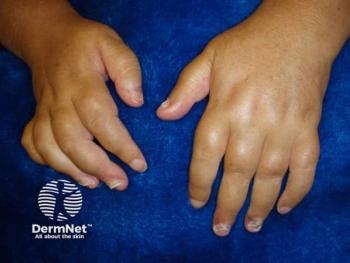
Study Results for Patients With Generalized Pustular Psoriasis
Aaron S. Farberg, MD, and Jeffrey Crowley, MD, examine the results of a study of generalized pustular psoriasis, discussing flares and common signs and symptoms.
Episodes in this series

Aaron S. Farberg, MD: There are a lot of comorbidities. It’s important to recognize all the demographics for patients with GPP [generalized pustular psoriasis]. The other important thing about all those charts, graphs, and demographics is what follows. We have some results, so I’m excited to discuss them. First up is figure 1, the number of documented GPP flares. You can see the percentage of patients with GPP had 1 to 13 flares. Dr Crowley, any comments on this chart?
Jeffrey Crowley, MD: If you’re having 13 flares, you’re probably never out of a flare during the time frame this study was conducted. Most patients have that big flare and don’t have another. A subset of patients is going to go on and have a second, third, and fourth flare. It’s hard to predict who those patients will be. The first thing to predict is when the flare stops. This study doesn’t delineate that. When is the flare considered no longer active? That’s when you start having less chatter in the EHR [electronic health record] about the flare symptoms and signs. It’s very interesting that most patients have 1 flare but some go on and have subsequent flares, and a few patients are yo-yoing up and down with this disease active.
Aaron S. Farberg, MD: That’s a very interesting point. We’re always looking to define the flare, but we it’s also important to know when the flare has subsided and when we’re essentially preventing the next flare.
We’ve spoken at length about what some of the signs and symptoms of GPP are and how you identify them. It’s great to hear it from people like Dr Crowley and me, but what do the data show us? What do we see? You can see at the top pain, psoriasis, and rash. Let’s look at some of the other ones. Dr Crowley, are there any you’d like to point out or that you think are important in your practice?
Jeffrey Crowley, MD: I want to reiterate pain. What other skin disease do we have that has a lot of pain? Things like hybridized sativa have a lot of pain. Some acute bullous diseases can be painful when they occur, but skin pain is a key finding. This is skin pain that these patients are reporting. These systemic symptoms are key. There are a bunch of them, including nausea, swelling, itch, chills, and fever. Those things can certainly be part of this disease. It’s interesting that some patients have GPP when it isn’t an acute flare. It’s chronically pustular psoriasis, and they often don’t have the systemic symptoms. It’s not always going to be there, even though in these acute eruptive flares, the patient is generally going to be ill.
Aaron S. Farberg, MD: It’s very important to look at and recognize this sort of information. When I’m prescribing a drug, I’ll usually look at the prescriber’s information and the top 3 adverse events, because that’s what I’m going to be discussing with my patient. What are you expecting? When you have GPP and you’re talking to clinicians, what are you expecting? Well, here are the top ones. I agree with Dr Crowley. Pain is such an important symptom that I use to gauge when is the flare over. But it’s up to the patient—the patient stops having to come in so often or stops telling me that their life has been significantly impacted by their pain. Another interesting 1 was fever. How often are you going to see a fever? We characteristically think of it as such, and perhaps in the acute phase it is, but are all your patients coming in with fevers?
Jeffrey Crowley, MD: No. That’s 1 of the important things. The patient shows up in urgent care or an ER, and they’re febrile and they have pustules. What’s that provider thinking? They’re thinking infection, infection, infection.
Aaron S. Farberg, MD: Hopefully they’re calling a dermatologist too.
Jeffrey Crowley, MD: I don’t know. Many of these patients are treated with antibiotics orally or IV [intravenously] prior to getting a diagnosis. What happens is they don’t get better? When they don’t get better, that’s when the call to the dermatologist occurs. Many of these patients are treated with antibiotics, which can sometimes make it difficult to know what’s going on because you can have acute generalized exanthematous pustulosis, which is often caused by drugs, including antibiotics. That could be a little difficult in terms of the diagnosis. That’s where getting a biopsy can be helpful.
Transcript edited for clarity
Newsletter
Like what you’re reading? Subscribe to Dermatology Times for weekly updates on therapies, innovations, and real-world practice tips.





















